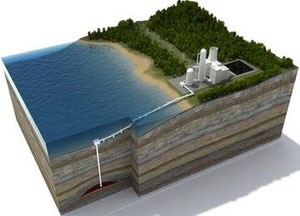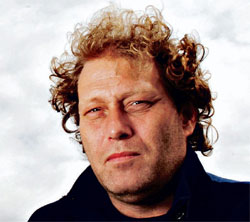‘A further regulatory boost is vital for CCS’
on
‘A further regulatory boost is vital for CCS’
Carbon capture and storage (CCS) is not very popular among environmental organisations. Greenpeace, for example, regards CCS only as an excuse of the energy industry to continue producing fossil-fuel based energy. WWF does not necessarily object to CCS, but does not want to see it subsidised. The Bellona Foundation, a well-known anti-nuclear NGO with offices in four countries, is an exception. Its President Frederic Hauge even declares that he is prepared to go ‘on the barricades’ for CCS. In this interview he explains why he believes CCS is indispensable – and should be boosted.
 |
| Carbon Capture and Storage is applied at Norway's Sleipner gas production field |
For its part, most of the energy industry is convinced of the necessity of CCS, but companies are reluctant to invest large sums of money into the technology, primarily because they regard the future regulatory regime for CO2-emissions as still highly uncertain. Another issue that concerns them is public acceptance. So far, in places where carbon storage is being considered in populated areas, the public opinion has not been favourable. However, as Frederic Hauge, President of the Bellona Foundation points out in an interview with EER, the public has hardly been engaged on this issue as yet. Most people hardly know what CCS is.
The Bellona Foundation, a highly influential and successful environmental organisation which campaigns against nuclear power and in favour of climate change measures, is unique among NGO’s in that it has fully embraced the necessity of CCS as a transition instrument. It is even carrying out its own CCS projects and participating in other international CCS ventures. It also operates a specialised website on CCS which it says contains ‘all you need to know about CO2 capture and storage’. EER asked Bellona’s President and founder, Norwegian Frederic Hauge, why he has taken up the CCS cause and what he thinks is needed to make this technology a success in the coming decades.
-Your organization is one of the major advocates among NGO’s for the large-scale implementation of CCS. What is so good about CCS?
All global greenhouse gas emission scenarios that give us a good chance of preventing catastrophic climate change include a significant amount of CCS. The more ambitious the scenario, the greater the role for CCS. In our own global greenhouse gas emission scenario report from 2008, entitled ‘How to Combat Global Warming’, we estimated that by 2050, CCS to store CO2 from fossil fuels, biomass and industrial processes in total will represent one third of mitigation compared to a business as usual scenario. Therefore the rapid application of CCS to achieve commercial maturity is essential. This is a concept that the industry and national governments are beginning to grasp. At least 7 European countries will have built a CCS equipped thermal power unit by 2015. The same is happening in the US, Canada, Australia and the United Arab Emirates.
-Industry experts and policymakers tend to believe in the necessity of CCS. Why do you think there is still so much resistance against CCS among the public and NGO’s.
There are still so few large-scale CCS projects operating today that few people have awareness of them. Seeing is believing! People can see windmills, they can install a solar panel on their roof. But the very fact of storing CO2 far below the ground in rocks is hard to picture in your mind unless you are a geologist. So yes, there is a lot of work needed to involve all stakeholders in an open discussion on CCS, especially local communities. NGOs and other independent bodies like academics must be given the resources to work on this.
-How do you assess the current initiatives by the European Commission in relation to CCS?
In March the European Union confirmed its decision to fund at least 8 CCS projects with up to 300 million EU emission allowances (EUAs) [i.e. emission rights under the European Emission Trading Scheme, editor]. Today these are worth about €4bn but they are set to be worth more in the future.
| ‘We are becoming increasingly active on the ground in the places where CCS projects are likely to happen, in order to stand on the barricades for CCS’ |
These were landmark decisions that underline the EU’s commitment to support the deployment and eventual commercial maturity of CCS. This has been a result of the realization that bold EU emission reduction goals cannot be attained without CCS.
-What about the role of the member states’ governments? Can we expect any major breakthrough from a particular national market at this point or should the EU bear the responsibility of introducing CCS further to the member states?

Click on the image to watch a presentation about CCS on the website of Bellona.
The EU needed to provide initial economic support so as to stimulate the development of CCS projects because member states were not doing enough. The ball is now in the court of national governments, who will need to top up the EU funding. Fortunately, this is happening. Various EU states, such as the UK and Spain have already committed to fund large-scale CCS projects. Most impressive is the UK, which despite disastrous public finances has announced its intention to fund four CCS demonstration projects. More governments will follow if they understand what may happen otherwise: unabated coal plants could turn into a “carbon price time bomb” as the price of CO2 emissions in the EU is expected to triple in the next decade.
-How likely is that CCS projects will be implemented en masse in Europe within the coming decade?
If we are successful in combating climate change, I trust that by 2020 CCS will be more attractive to include in new coal or gas-fired power plants than building such plants without CCS. After the initial CCS projects the cost of the technology is bound to fall radically through economies of scale and technical progress. This will definitely provide a boost towards a wider application of CCS globally. But to achieve that, a further regulatory boost is vital to give industry the predictability needed for a return on its investments.
Right now we’re in a Catch-22 situation, where we are confident CCS will be a relatively inexpensive emission abatement option for society, yet no company is investing massively in CCS because they are afraid that the ETS rules [the rules of the EU’s Emission Trading Scheme] will be twisted in favour of unabated coal-fired power once carbon prices rise. The setting of limits now to the amount of CO2 any power plant may emit per kWh electricity produced in the future – known as CO2 emission performance standards – could be the way to get out of this stalemate.
-There are quite a few skeptics who say that CCS is an expensive technology that cannot compete with other alternative energy production technologies.
CCS is actually cheaper per tonne of CO2 avoided than some renewable energies that are being built on a big scale in many countries, such as Concentrated Solar Power (CSP), which we believe also has a crucial role to play. Why is CSP being built in many countries? Because it receives massive subsidies, like any new technology not yet deployed at scale. CCS does not get such subsidies. This has to do with how CCS has been framed by many companies as a fig-leaf for new coal-fired power plants. In other words as just a potential measure that they will buy them some time. Of course you don’t want to subsidise that.
-Does this mean that CCS can only be viable with substantial amounts of subsidies?
No. If companies start to believe that the ETS is here to stay, that governments are serious about climate change and that the price of CO2 emissions therefore will increase radically over the coming years, then much larger private investments in CCS would be made. Unfortunately too many companies do not yet have enough confidence in the ETS to bet on that. That is why governments are looking at other ways of supporting CCS – but without using public budgets. In the UK, for instance, the idea is to introduce an extra charge on electricity consumption to fund CCS. In essence, this is a system that may come to resemble feed-in tariffs for renewables.
-What is your short to medium term outlook for the ongoing CCS projects in Europe? Is it likely to talk about a significant expansion within the coming decade or will this require more than a generation? And what about the required infrastructure?
I am confident that by 2015 we will have a dozen or so large-scale CCS projects in Europe. But that’s just a start! If we are to make sufficiently deep CO2 emission cuts by 2030, we will probably need more than a hundred CCS plants in Europe. So it means we need to think way ahead when building the transport and storage facilities for the first projects. As to the infrastructure, when the first French TGV railway was built, it was between Paris and Lyons, although it would have been much shorter and cheaper to simply build it between, say, Paris and Lille. But everybody understood that the first line would be more useful if it would serve as a backbone to which other lines could be connected later. Similarly, the first CO2 pipelines and shipping lines need to be built as a likely core of a future European CO2 infrastructure system.
-Which national European market has the most potential for CCS and offers the best conditions?
Let us keep in mind that we have to think European when imagining future infrastructure projects. This may particularly be the case for CCS, where capture and storage of CO2 may take place at several hundred kilometers of distance in between. Countries with many large CO2 emission points are most suitable for CO2 capture, for instance those with a high reliance on coal for energy production that plan to construct even more coal plants, such as Greece, UK, Poland and Romania. These countries should develop their technological know-how now rather than paying dearly for the technology later on! This the reason why the British government announced last year that new coal-fired power plants will need to fully capture and store CO2 by 2025 at the latest.
As to storage, this may happen in the same places as the capture, or it may happen elsewhere. There are many regions in the UK, Poland, Italy and Romania, for instance, that we know are very well-suited for storage because there has already been lots of drilling to explore the underground, especially for oil and gas extraction. In other regions, including much of Greece, we simply do not know enough about the potential for storage yet.
-How do you intend to further improve public acceptance of CCS? What are the main initiatives that you are taking?
Bellona has launched its Bellona Environmental CCS Team (BEST) as a means to develop all our CCS-related activities around Europe and beyond. It consists of three main elements.
|
EER published an extensive report on the EU’s CCS policy in December written by our correspondent in Brussels Hughes Belin. You can check it out here "EU making headway on getting carbon-capture ready". |
Secondly, at our headquarters in Oslo we have a team of scientists dedicated to work on environmental and health aspects of CCS and to be a watchdog to ensure industry and government do not make tempting short-cuts in deploying CCS.
Thirdly, we are becoming increasingly active on the ground in the places where CCS projects are likely to happen or should happen, in order to stand on the barricades for CCS, to raise the issue on the public agenda and get the public involved. That’s why Bellona now has people in Greece, Hungary, the UK and – soon – in Poland.
|
Frederic Hauge and Bellona
|


 In 1986, at the age of 20, Norwegian Frederic Hauge established the Bellona Foundation. Through investigation, documentation, legal action and non-violent activism, Bellona has dramatically impacted the way Norwegians think of and relate to environmental matters. In addition, the NGO has facilitated concrete changes in environmental policies among political and industrial leaders in Norway and internationally.
In 1986, at the age of 20, Norwegian Frederic Hauge established the Bellona Foundation. Through investigation, documentation, legal action and non-violent activism, Bellona has dramatically impacted the way Norwegians think of and relate to environmental matters. In addition, the NGO has facilitated concrete changes in environmental policies among political and industrial leaders in Norway and internationally.
Discussion (0 comments)